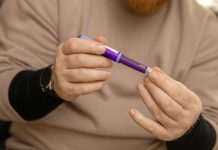
Blood sugar levels are like the ocean’s tides: constantly changing, influenced by a variety of factors, and crucial for navigating the day successfully. However, when these levels spike too high, it can lead to turbulent waters.
Known as hyperglycemia in medical terms, blood sugar spikes can be a sign of underlying health issues such as diabetes. This article aims to shed light on the causes, symptoms, and prevention of blood sugar spikes, presenting the science in a way that’s accessible to everyone.
At its core, blood sugar (glucose) is the body’s primary source of energy, derived from the food we eat. It’s a crucial fuel for our cells, particularly in the brain. However, like anything in life, balance is key.
Too much glucose in the bloodstream can lead to a range of health problems over time. The regulation of blood sugar is primarily the job of insulin, a hormone produced by the pancreas.
Insulin helps glucose enter the cells, keeping blood sugar levels in check. When this process is disrupted, blood sugar levels can rise, resulting in a spike.
Several factors can cause these spikes. The most obvious is diet—consuming high amounts of sugar or carbohydrates can lead to sudden increases in blood sugar levels. But it’s not just what you eat; it’s also when and how much.
Skipping meals, for example, can lead to overeating later, which can cause glucose levels to surge. Physical inactivity is another culprit. Exercise helps use up glucose as energy, so a lack of activity can leave excess sugar circulating in the bloodstream.
The symptoms of a blood sugar spike can vary but often include frequent urination, increased thirst, headaches, fatigue, and difficulty concentrating.
Over time, repeated spikes can lead to more severe conditions, including damage to the blood vessels, nerves, and organs. This underscores the importance of managing and preventing these spikes, especially for individuals with or at risk of diabetes.
Research has shown that one of the most effective ways to prevent blood sugar spikes is through diet. A diet rich in fiber, for example, can slow the absorption of sugar into the bloodstream, helping to maintain stable glucose levels.
Whole grains, vegetables, fruits, and legumes are excellent sources of fiber. Similarly, choosing foods with a low glycemic index (GI), which measures how quickly foods raise blood sugar levels, can also help prevent spikes.
Regular physical activity is another powerful tool for managing blood sugar. Exercise increases insulin sensitivity, which means your cells are better able to use the available sugar in your bloodstream. Even simple activities like walking can have a significant impact.
Monitoring blood sugar levels is also crucial, particularly for those with diabetes. This can help identify patterns in blood sugar fluctuations, making it easier to adjust diet, exercise, and medication routines to maintain balance.
Finally, stress management plays a role in preventing blood sugar spikes. Stress triggers the release of hormones such as cortisol and adrenaline, which can increase blood sugar levels.
Techniques like mindfulness, meditation, and regular exercise can help manage stress effectively.
In conclusion, navigating the waters of blood sugar management requires understanding the causes and symptoms of spikes, as well as implementing effective prevention strategies.
Through a balanced diet, regular physical activity, careful monitoring, and stress management, it’s possible to maintain smooth sailing and protect against the choppy waters of hyperglycemia.
With the right knowledge and tools, anyone can manage their blood sugar levels effectively, ensuring a healthier journey through life.
If you care about diabetes, please read studies about a cure for type 2 diabetes, and these vegetables could protect against kidney damage in diabetes.
For more information about diabetes, please see recent studies about bone drug that could lower risk of type 2 diabetes, and results showing eating more eggs linked to higher risk of type 2 diabetes.
Copyright © 2024 Knowridge Science Report. All rights reserved.



